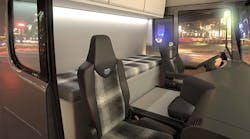With current improvements in vehicle automation and artificial intelligence (AI), connected and automated vehicles (CAVs) will be an important part of the future urban transportation. Various industries, along with public agencies, universities, and others, have already started exploring the potential applications and benefits of these technologies. The healthcare industry is one of the industries that could benefit from CAV technologies. More specifically, the human factor in the automated vehicle system—either as a driver in the very early stages of the technology or as passengers in the fully automated vehicles—creates a critical opportunity for the healthcare industry to become active in the discussions around CAVs.
Research done by the Center for Automotive Research shows that that automated driving technologies can contribute to the healthcare industry in multiple ways:
1. Increased vehicle and occupant safety
According to the Nation Highway Traffic Safety Administration (NHTSA), around 94% of motor vehicle crashes are caused by human error. With advanced divining systems, automated vehicles (AVs) offer the potential to improve driving safety and reduce the number and severity of crashes by reducing the human error component contributing to crashes. Considering the arising concerns regarding fatalities caused by distracted driving and DUI, and the increasing number of elderly drivers, automated driving systems hold the promise of a large step toward a safer future for all road users.
2. Passive health monitoring
While some have raised concerns regarding the possibility of negative impacts on human health due to AVs by encouraging more car trips instead of more active modes of transportation such as walking and biking, AVs also have the potential to improve human health by measuring our health parameters enroute through passive health monitoring systems. This could contribute to identification of both acute concerns (e.g., early warning of an imminent heart attack or asthma attack while in the vehicle) and long-term issues by providing a frequent, probably daily for many, update on critical health parameters.
With the innovations happening in biosensors, AI, and remote diagnosis, the act of measuring health parameters and vital signs will become more convenient, mobile, and cost effective. Biometric sensors can be integrated into the backrest, seat belt, or seat cushion to measure vital signs passively and store our data in the clouds. More data points over time help the doctors to have a more reliable basis for diagnosis than occasional visits. And in case of any abnormalities, the system will either notify the driver (or a passenger) or send the data to a doctor for a later feedback.
3. Faster emergency responses
With the advent of AVs, emergency response can be faster, too. With evidence of an emergency situation (from biosensors or other source), the passenger monitoring system can send a warning to the person to call for the emergency service. If the vehicle occupant is not alert or not responsive to the warnings, the vehicle can communicate the information to the emergency service centers pretty fast and stop on the side of the road to wait for the ambulance. Accurate location information coming from the vehicle’s GPS system will enable the first respondents to find the car in an emergency situation faster and easier. Engineers hope to develop fully automated vehicle systems that will be able to communicate with the nearest hospital and drive the person in the emergency situation to the hospital.
4. Mobility for senior citizens and people with disabilities
According to the Journal of the American Medical Association, approximately 3.6 million Americans miss medical appointments each year due to transportation problems. With the world population getting older, AVs will be able to provide 24/7 mobility services to the senior citizens and people with disabilities to go to their appointments conveniently while keeping their independence. Past research has shown both the therapeutic benefits and cost effectiveness of prevenatitive care in reducing the need for emergency medical care.
5. New form of mobility
Finally, AV technology developers are promising to provide a new form of mobility both for people and goods that can transform the way people get around the cities. For the healthcare providers, this mobility transformation can happen in multiple ways—as an on-demand automated shuttle to hospitals (to be used by patients and employees), for delivery of medical supplies, or even as a mobile workplace for on-demand health services, such as measuring vitals, running lab work, or holding consultations with nurses; these latter are especially promising for increasing access to healthcare in distressed communities.
Developments such as those described above show great potential for aligning emerging vehicle technology with healthcare needs. The performance of sensors and supporting AI data-mining techniques could be amplified by collaboration between advanced driving technology developers and healthcare providers. This could lead to the development of more sensitive sensors and accurate health monitoring systems for AVs. It also could help physicians access patient health data on a regular basis and thus better monitor patients with chronic diseases, such as high blood pressure, diabetes, and cardiovascular problems.
The applications of medical sensors in vehicles is a burgeoning field of research and development, and this field offers many research and application areas to explore. The Center for Automotive Research is studying the potential applications of AVs in the healthcare industry and welcomes opportunities to work with other stakeholders interested in this topic.
Zahra Bahrani Fard is a transportation systems analyst for the Center for Automotive Research, an independent research organization based in Ann Arbor, Michigan. This article originally appearedas a feature story on CAR’s website.
